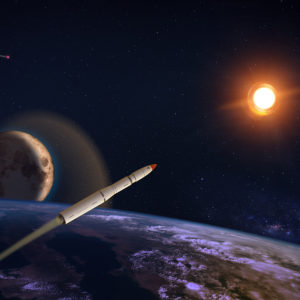During the decades of the Cold War there were numerous arms races between the United States and the Soviet Union. First, in the 1940s, was the race to develop nuclear weapons. In the 1950s and 1960s the two superpowers raced to see who could be first to deploy jet bombers and land- and sea-based ballistic missiles that could carry nuclear warheads.
There was even a race to land a man on the moon. Starting in the 1980s, the United States took the lead in the development of extremely accurate conventional weapons such as laser-guided bombs and missiles that used Global Positioning Satellite signals.
Now a new arms race has begun, one in which America’s rivals, particularly Russia and China, may be ahead. This is the race to build and put in the field super-fast or hypersonic weapons. The military defines a hypersonic weapon as one that travels at least Mach 5, or five times the speed of sound.
Advanced hypersonic missiles can fly at Mach 15 or more. In comparison, commercial aircraft fly at around Mach 1 while some military jets can push themselves to around Mach 3, but only for a short time.
There are two basic types of hypersonic weapons: super-fast cruise missiles and boost glide vehicles that are mounted on ballistic missiles. Hypersonic cruise missiles generally stay within the atmosphere and can be launched from aircraft, ships, submarines and land-based units. Boost glide vehicles are lofted by a ballistic missile to the edge of space from which point they use their speed and aerodynamic design to skip along the top of the atmosphere for up to 10,000 miles.
Hypersonic weapons have several advantages over existing cruise and ballistic missiles. Because they fly so fast, they can close on their targets in a very short time. Compared to slower weapons, their high speed means that these weapons can evade or simply outrun any existing air and missile defenses.
In fact, some hypersonic weapons are so fast and maneuverable that they are unlikely to even be seen by existing radars. This means they could be the perfect first strike weapon.
Senior U.S. defense officials have publicly stated that Russia and China are ahead of us in this new arms race. Last year, Air Force Gen. John Hyten, commander of U.S. Strategic Command, testified before the Senate Armed Services Committee that “both Russia and China are aggressively pursuing hypersonic capabilities. We’ve watched them test those capabilities.”
China has publicly claimed that it has deployed a hypersonic boost glide weapon that can attack U.S. aircraft carriers operating in the Western Pacific. Last December the Russian military published a video of one of its fighters carrying a hypersonic cruise missile called the Kinzhal, or dagger. According to Russian sources, this missile flies 10 times faster than the speed of sound, has a range of more than 1,250 miles and can carry a nuclear or a conventional warhead.
The U.S. has yet to deploy a single hypersonic weapon. The Department of Defense is spending billions not only to develop its own hypersonic weapons as fast as possible but also the sensors and defenses with which to defeat them. Work is underway on both land and air-launched hypersonic cruise missiles.
The U.S. Missile Defense Agency is beginning work on a new system of space-based sensors that could track hypersonic glide vehicles. The Pentagon is also looking at exotic technologies such as laser weapons to defend against hypersonic weapons.
The outcome of the race to build super-fast weapons could determine the balance of power in the world for much of the 21 century. The U.S. cannot afford to come in second.

